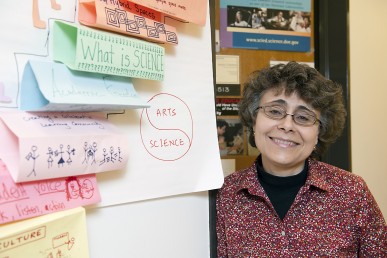Creating ‘a safe, nurturing environment’ for science learners

Maria Varelas treasures the value of storytelling in the teaching of science. Photo: Roberta Dupuis-Devlin/UIC Photo Services
2013 Silver Circle Award
Since 1966, the Silver Circle has been presented to some of UIC’s best teachers. What makes the award especially meaningful is its selection committee: the graduating seniors.
Maria Varelas
Professor of curriculum & instruction
College of Education
A colleague dubbed Maria Varelas “fervor-ball,” and she accepts the nickname happily.
Her first “students,” when she was a third-grader playing school, were her mother’s 20 flowerpots on the veranda in Athens, Greece. She gave them names, talked to them and graded them at the end of the day.
That was how she discovered that she enjoyed “creating a safe, nurturing environment” for learners.
Years later, she was drawn to physics for giving her “a sense of how the world came to be.” She admired a popular physics professor at the University of Athens whose interactive, call-and-response lectures were always packed.
“We would see that we were developing scientific stories along with him. ‘Think with me,’ he would exclaim, in the classroom or in the lab,” she says.
Aware of the power of storytelling, Varelas completed her bachelor’s degree with a thesis on the role of humor in teaching physics.
Since joining UIC in 1993, she has won seven awards for teaching students in the College of Education how to teach science.
“Many undergraduates get paralyzed by science. Many haven’t had very positive experiences with science in their K-12 schooling,” she says.
“They have to deconstruct their negative experiences and build new ones, and see themselves as doers of science.”
Varelas models science teaching by engaging her students in exercises as if they were learners themselves.
“I make explicit the teaching moves I do in the classroom — pausing, saying, ‘What did I just do?’ and ‘What could I have done?’” she says.
Varelas’ research and service in the Chicago Public Schools inform her teaching.
“Many of my students were CPS kids themselves,” she says. “To ponder about teachers who had limited resources but plenty of creativity and trust in what their kids bring to the classroom, create spaces for students to blossom, is powerful.”
Varelas says she learns every time she teaches her class. Good teachers are great listeners, she says.
“Hear what the kids are saying. Honor their meaning-making. It may not agree with what is scientifically known.
“But celebrate where they are, and help them move to new places.”
